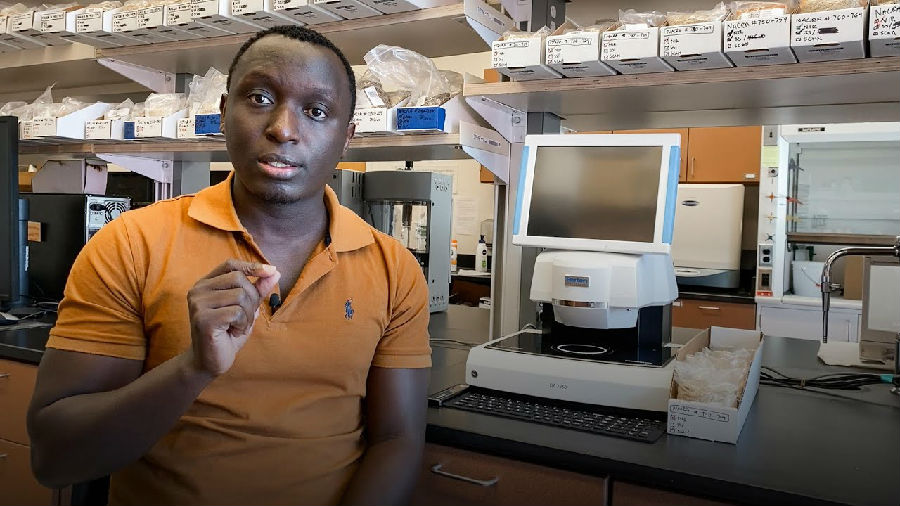Like so many of you, when I'm hungry, I open the fridge and get myself something to eat any time I want.
和许多人一样,当我饿了,我会去开冰箱,任何时候都能找到东西来吃。
This is something most of us who live in a developed country don't think much about.
住在发达国家的人,对此多半不会多想什么。
However, it is a luxury that I didn't think I would ever have in my life when I lived in a refugee camp in Tanzania 23 years ago,
然而,二十三年前,我住在坦桑尼亚的难民营时,我根本不敢想象在我有生之年能享受这种奢侈,
or even seven years ago, when I was living in my home country of Rwanda before I moved to the USA.
或者甚至七年前,我住在卢旺达的家中,还没搬来美国时也是如此。
I was only seven years old when my home country of Rwanda went through the tragedy of the genocide that took so many lives,
我才七岁时,我的祖国卢旺达经历了大屠杀的悲剧,许多人丧命,
and they made us flee the country, and we became refugees.
我们被迫逃出国,成了难民。
Life in a refugee camp -- it wasn't life. It was survival.
在难民营的生活--那不是生活,那是生存。
I saw a lot of people dying from disease, poor sanitation, hunger.
我看到很多人因为疾病、卫生条件不佳、饥饿而死。
Food became a rare commodity. There were bad days.
食物是很罕见的东西。有些日子很糟糕。
My family and I would survive on the leaves and grasses from the forest.
我和我的家人为了存活得要吃森林里的叶子和草。
There were also worse times, when we would go two or three days without anything to eat at all, only drinking water from the swamp.
还有更糟糕的时候,我们可能会有两、三天完全没有东西可吃,只能喝沼泽中的水。
After three years in a refugee camp, we decided to return back to Rwanda. And our struggle with food continued.
在难民营待了三年之后,我们决定返回卢旺达。我们的食物困境仍然持续着。
However, farming proved to be the only reliable source of food.
然而,事实证明农耕是唯一可靠的食物来源。
But our food lacked the nutritional diversity,
但我们的食物缺乏营养多样性,
and we continued to depend on food assistance from the United Nations World Food Program to balance our diet.
我们持续仰赖世界粮食计划署提供的食物协助来平衡我们的饮食。
Still today, more than 70 percent of Rwandans, they work in the agriculture sector.
至今,仍然有超过70%的卢旺达人从事农业方面的工作。
But malnutrition and stunting remain rampant.
但营养不良和发育迟缓仍然无所不在。
I came to realize that food insecurity and malnutrition were not happening because people were not farming enough;
我渐渐了解,粮食不安全和营养不良发生的原因并非因为人民耕作不足;
it was because people were not farming the right crops.
而是因为人民没有耕作对的作物。
I eventually left Rwanda and moved to the USA for graduate school and discovered the possible solution to that problem.
我最终离开了卢旺达,搬到美国,就读研究所,发现了这个问题的可能解决方案。
And that solution is quinoa. Quinoa is indigenous to the Indian regions of South America, in countries like Bolivia, Peru...
解决方案就是藜麦。藜麦是南美洲印地安区域的原生作物,在玻利维亚、秘鲁等国家都有。
And it's very well-known for its powerhouse nutrient, and the crop has all the nine essential amino acids, making it a complete protein.
它因为超级营养而闻名,必需胺基酸共九种,这种作物通通都有,因此它是完整的蛋白质。
But unfortunately, quinoa is not cultivated as much in different parts of the world.
但不幸的是,在世界的其他地方,藜麦的栽种就没那么常见。
In Rwanda, for example, beans are the only thing that kept so many of us alive during those times of hunger and starvation.
比如,在卢旺达,在饥荒挨饿的时候,让我们许多人能活下去的就只有豆类。
As a matter of fact, Rwanda is the number one beans-consuming country in the world per capita.
事实上,全世界人均豆类消费排名第一名的国家就是卢旺达。
In this part of Africa, beans are one of the only crops that provide immediate food source, because you can eat beans at every stage of growth.
在非洲的这个地区,能立即提供食物源仅有几种作物,豆类是其中之一,因为豆类在生长的任何一个阶段都可以食用。

We eat beans, leaves and green beans before harvest.
我们会在收获之前吃豆子、叶子和青豆。
Unfortunately, you cannot cultivate beans in the same field season after season.
不幸的是,无法在同一块田地上一季接着一季栽种豆类。
You need to ensure there is regular rotation to avoid disease and pests.
必须要用轮耕的方式确保不会有疾病和害虫。
Like beans, farmers can enjoy the nutritious quinoa leaves.
和豆类一样,农民也能享有藜麦叶的营养。
While beans are considered nutritious, quinoa has far more micronutrients,
虽然豆类被认为很营养,藜麦的微量营养素多更多,
and with quinoa, you can make many different food products and drinks than beans.
且用藜麦能制造出多种食物产品和饮料,比豆类多很多。
In 2015, alongside my research team at Washington State University, we introduced quinoa in Rwanda for the first time.
2015年,我和我在华盛顿州立大学的研究团队初次在卢旺达推动藜麦。
We tested 20 varieties of quinoa to see the adaptability in three ecological zones of Rwanda. And the results were astonishing.
我们测试了二十种不同的藜麦,想知道它们在卢旺达三个生态区的适应性如何。结果很惊人。
Among the 20 varieties we tested, 15 of them showed the potential to grow well in Rwanda's climate.
在我们测试的二十种品种当中,有十五种都有潜力可以在卢旺达的气候下生长良好。
And later, we started Quinoa Model Farmers Program. We gave those potential varieties to farmers to grow in their farm and community.
后来,我们展开了藜麦示范农民计划。我们给农民那些有潜力的藜麦,让他们种在他们的农田和小区中。
We started with 12 farmers, and three years later, we are now working with around 500 farmers,
一开始只有十二名农民,三年后,现在和我们合作的农民有五百名左右,
including my mother, who is locally known as "the queen of quinoa" because of her work in helping other farmers adopt this crop.
包括我母亲,在当地她被称为“藜麦女王”,因为她致力于协助其他农民采用这种作物。
We give them seeds, train them how to grow it and how to cook it.
我们提供种子给他们,训练他们如何种植、如何烹饪。
And farmers are pretty creative, coming up with recipes of their own.
农民都很有创意,想出他们自己的食谱。
And we've started seeing remarkable changes in their lives,
我们看到他们的生活开始出现重大改变,
including success stories that many of them can now have access to nutritious food three times a day.
包括一些成功故事,许多农民现在一天可以吃到三餐有营养的食物。
I'd like to note that quinoa is not meant to entirely other crops.
我想要强调,种藜麦的本意并不是要排挤其他作物。
We introduced quinoa as a supplement to create overall health and nutrition, rounding out diet to combat chronic malnutrition.
我们是把藜麦当作补充食品来推动,目的是创造全面的健康和营养,让饮食更丰富,以对抗长期的营养不良。
We have started this model with quinoa in Rwanda, but it can be replicated in different countries experiencing hunger and malnutrition.
我们在卢旺达开始用这个藜麦模式,但可以将它复制到经历饥荒和营养不良的其他国家。
About one in nine people in the world suffer from chronic malnutrition.
全世界九个人中大约就有一个人受到长期营养不良所苦。
We have started research collaboration with institutions in countries like Kenya, Malawi, Uganda and other countries experiencing hunger and malnutrition.
我们展开了一些研究合作,合作的机构遍及各国,包括肯尼亚、马拉维、乌干达,及其他经历饥荒和营养不良的其他国家。
And quinoa isn't the only magic crop.
藜麦不是唯一的神奇作物。
There are several crops with high adaptability and nutritional value, crops like millet, sorghum, fonio, barley, oat, to name a few.
还有数种作物都有极强的适应力和极高的营养价值,包括小米、高粱、福尼奥米(蒸粗麦粉)、大麦、燕麦等。
These crops have high adaptability and respond well to climate change.
这些作物的适应力极强,且很能因应气候变化。
You can grow these magic crops in different parts of the world, bridging the gap, so that there is accessible nutritious food for everyone.
可以在世界上不同地区种植这些神奇的作物,缩小差距,让人人都能取得有营养的食物。
I know how it feels to be hungry. I've been there. And I know how it feels to be malnourished, because I've been there, too.
我知道饥饿的感觉。我曾感受过。我知道营养不良的感觉,因为我也经历过。
Introducing crops with high biodiversity, adaptability and nutritional value
推动具有高生物多样性、高适应力,及高营养价值的作物,
will play an important role in creating food security, seed sovereignty and sustainable production in communities and countries that are experiencing hunger and malnutrition.
在创造粮食安全、种子自主权,及永续生产上都将扮演重要的角色,协助经历营养不良和饥荒的社区及国家。
Having nutritious food should not be a luxury. There is a need to ensure that there is accessible and affordable nutritious food for everyone.
吃得到有营养的食物不该是种奢侈。必须要确保人人都能取得且负担营养的食物。
And this is a step towards making it a reality. Thank you.
这是朝向实现这个理想迈进一步的方法。谢谢。











